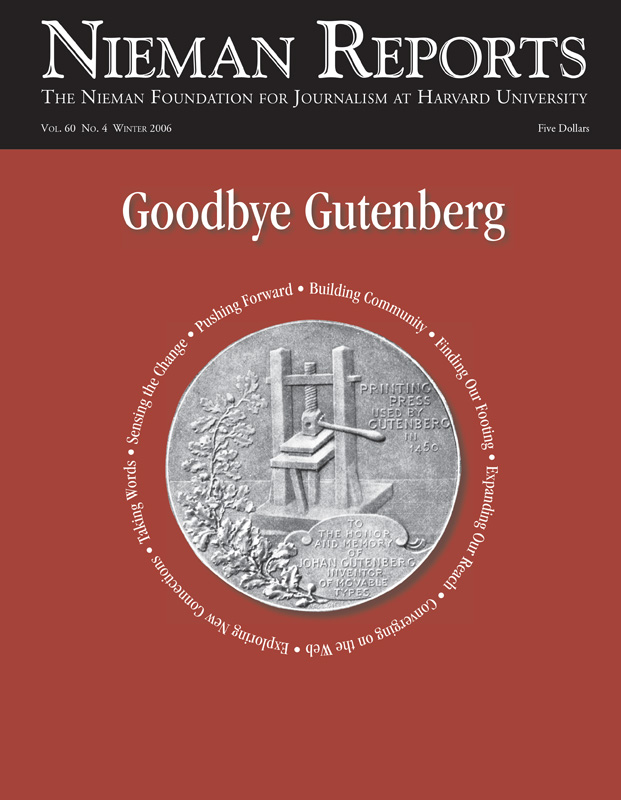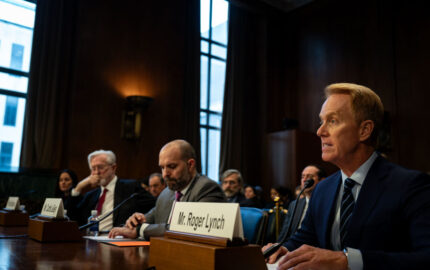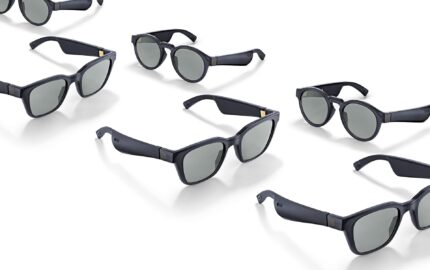
Goodbye Gutenberg
Journalism is on a fast-paced, transformative journey, its destination still unknown. That the Web and other media technologies are affecting mightily the practice of journalism is beyond dispute. Less clear is any shared vision of what the future holds.
In this issue, words about journalists' experiences in the digital era transport our vision forward, while our eye takes us on a visual voyage back to a time when newspapers wove communities together.
This September our newly appointed multimedia editor and our managing editor invited 90 newsroom colleagues at the Wisconsin State Journal in Madison, Wisconsin, to a brown-bag lunch to talk about "our rapidly expanding online initiatives." We expected about a dozen people, so we booked a conference room with 20 chairs. About 50 staffers balancing laptops, cell phones, notebooks and sandwiches jammed into the room, many sitting on the floor or craning their necks from the packed hallway.
With hindsight, I realized I made a huge error that day. It had nothing to do with booking a larger room. I should have had the sense to pull out my Smartphone and take a video of the scene to send to the stock analysts who make me crazy with their conclusions that the newspaper industry is not a good bet for investors because it does not have the necessary enthusiasm for the multimedia world.
In the absence of streaming video, I offer this dispatch from flyover land to answer those critics and scholars who are not sure that the newspaper industry can fulfill the mandate to transform itself in the face of the "disruptive change" of the Internet.
I am intrigued by media consultant and critic Jeff Jarvis's "Number One Lesson of the Internet." He argues that a media company has "to give up control of the Internet in order to gain control." For me, the process of gaining control becomes a little more proactive and involves the serenity principle. As editor of the State Journal, I work very hard to accept the things I cannot change, find the courage to change the things that I can, and seek the wisdom to know the difference. It's the part about finding the wisdom that scares me.
Great journalism has always involved risks. And newsrooms acting with wisdom in this digital era appear to be places in which top editors are comfortable taking big risks often with little financial support. There isn't time to wait for the industry, as a whole, to come up with a patch to put on our tattered business model. Instead, editors with courage are taking what we know about journalism and putting it to work in the digital arena while we fervently hope that the business side can figure out the economics to support what journalists are supposed to do.
I have worked for seven newspapers. At some, editors in charge of the newsroom made it very clear that they would not cooperate with the Web operation, mostly out of fear that circulation would drop and journalism, as they practiced it in print, would disappear. So it is not a surprise that newspaper editors sometimes get hostile vibes from their peers on the Web site. Healing such rifts is essential. Nor does it surprise me that given papers' bleak advertising picture, large news organizations funnel new technology to places now generating advertising dollars and not into newsrooms.
None of this means that we who inhabit these newsrooms should sit on our hands. Our digital competition is increasingly entrepreneurial and nimble and often embarrasses us with its low-cost technological wizardry. In some cases, we should first apologize for not "getting it" earlier, even if we were not directly in charge. And then we need to push our slow moving bureaucracies to give us the tools. If that doesn't happen, we need to figure out ways to "create" the generally low-cost tools and skills we need.
Reader's Choice
RELATED WEB LINK
Reader's Choice Poll Announced
– www.madison.com/wsjWe tried to do this at the State Journal with a very simple yet elegant tool called Reader's Choice poll. This idea was hatched by Managing Editor Tim Kelley and me in an effort to signal to readers our seriousness about interactivity. The cost involved programming time to create the ballot that appears on our Web site on weekdays—on which readers vote for which of four or five story choices they'd most like to see on the next day's front page—and an editor's time to manage the voting. Ten months after we came up with the idea, the first ballot appeared on our Web site.
RELATED ARTICLE
"The Quickening Pace of Change"
– Ellen FoleyOn most days we receive between 100 and 200 votes in a news market arena of about 450,000 people. We'd like for the number of votes to increase, but financial resources to spur more activity aren't available. Now, almost a year into this effort, we are pondering how the newsroom can take this important experiment to a new level. Can we pool e-mail contacts into a group list and send daily reminders to potential voters? Which person in the newsroom could do this using Outlook? Can we afford to hire a programmer who can improve the online balloting process? Should we sacrifice some of our reporting staff's time to try to increase participation?
A number of news organizations, many of them national, have written and aired stories about our Reader's Choice poll, characterizing it as an enterprising way to connect with readers. But at our paper, we aren't getting much traction for it outside of the newsroom. We find more awareness of our project at conferences in Boston, for example, than we do in Madison.
What's been interesting for us to learn through Reader's Choice is that the readers who vote consistently do choose weighty stories. On one day recently readers voted onto Page One a lengthy package of stories on the gubernatorial election. Competing for this front page spot was a story about physicists' discovery of what has the potential to produce a Star Trek-like cloaking device. Such decision-making has surprised—and encouraged—our editors, who've been told by studies and in training sessions that time-starved readers want only news-you-can-use and entertaining breaks to ease the strain of their day.
For now our sputtering experiment continues. As the tool for tallying votes improves, we will be able to gather more information about what our readers want—and expect—from the newspaper. And such strategies will equip our younger editors, those in their 30's and 40's, with information that we hope can keep our journalism robust in the digital age.
Advancing on the Web
AUTHOR'S NOTE
At www.madison.com/wsj the Wisconsin State Journal shares a portal with other media outlets.Two years ago the State Journal was somewhat sleepily posting three to five of our newspaper's stories a day on our Web site. Today nearly every print story gets posted to the Web site, and staff at the paper blog. On the Web site, we present forums on specific topics, along with audio slide shows, breaking news alerts, and other Web-only content. Video is next for us. Our TV station partner, which installed a camera outside my office, will air interviews with our reporters on major stories. After this happens, we will tackle streaming video with our new digital cameras.
While we take pride in steps we are taking to enter the digital era, we remember that our newsroom's ability to report the news remains foremost. The recent school shooting in nearby Cazenovia, Wisconsin, in which a high school freshman was charged with killing his principal, reminded us of this as our newsroom excelled in its coverage of the day's tragic events. Our series on tainted city water and another examining the issues involved with stem cell research—each of which had unique online features—are among the best examples of enterprise reporting that I've seen in 30 years.
What we, as editors, struggle most with is figuring out what we must give up as we try to move in the many new directions brought to us by the Web. A few years ago editors were not obsessed with e-mail pushes, online ballots, reader/user interactivity while, at the same time, working to come up with fresh angles for print stories about school shootings. Our jobs, at least how we practice them today, and our comfort level with all the new directions in which we are being asked to turn simultaneously has to do with the kind of journalism we will practice. My colleagues and I will need to tap our collective wisdom on how to rock the boat because our jobs, retirement funds, and ability to pay for our family's health care are also on the line.
From our perch in Madison, Wisconsin, we look to the broader community of journalists for good ideas that might instruct and guide us on our way into digital journalism. For now, we're taking some risks, trying some new things, and delighting in the knowledge that journalists who work here will pack conference rooms on their own time to figure out how to take what we do best and find different ways to bring it to old and new audiences.
Ellen Foley joined the Wisconsin State Journal and madison.com/wsj as editor in April 2004.
With hindsight, I realized I made a huge error that day. It had nothing to do with booking a larger room. I should have had the sense to pull out my Smartphone and take a video of the scene to send to the stock analysts who make me crazy with their conclusions that the newspaper industry is not a good bet for investors because it does not have the necessary enthusiasm for the multimedia world.
In the absence of streaming video, I offer this dispatch from flyover land to answer those critics and scholars who are not sure that the newspaper industry can fulfill the mandate to transform itself in the face of the "disruptive change" of the Internet.
I am intrigued by media consultant and critic Jeff Jarvis's "Number One Lesson of the Internet." He argues that a media company has "to give up control of the Internet in order to gain control." For me, the process of gaining control becomes a little more proactive and involves the serenity principle. As editor of the State Journal, I work very hard to accept the things I cannot change, find the courage to change the things that I can, and seek the wisdom to know the difference. It's the part about finding the wisdom that scares me.
Great journalism has always involved risks. And newsrooms acting with wisdom in this digital era appear to be places in which top editors are comfortable taking big risks often with little financial support. There isn't time to wait for the industry, as a whole, to come up with a patch to put on our tattered business model. Instead, editors with courage are taking what we know about journalism and putting it to work in the digital arena while we fervently hope that the business side can figure out the economics to support what journalists are supposed to do.
I have worked for seven newspapers. At some, editors in charge of the newsroom made it very clear that they would not cooperate with the Web operation, mostly out of fear that circulation would drop and journalism, as they practiced it in print, would disappear. So it is not a surprise that newspaper editors sometimes get hostile vibes from their peers on the Web site. Healing such rifts is essential. Nor does it surprise me that given papers' bleak advertising picture, large news organizations funnel new technology to places now generating advertising dollars and not into newsrooms.
None of this means that we who inhabit these newsrooms should sit on our hands. Our digital competition is increasingly entrepreneurial and nimble and often embarrasses us with its low-cost technological wizardry. In some cases, we should first apologize for not "getting it" earlier, even if we were not directly in charge. And then we need to push our slow moving bureaucracies to give us the tools. If that doesn't happen, we need to figure out ways to "create" the generally low-cost tools and skills we need.
Reader's Choice
RELATED WEB LINK
Reader's Choice Poll Announced
– www.madison.com/wsjWe tried to do this at the State Journal with a very simple yet elegant tool called Reader's Choice poll. This idea was hatched by Managing Editor Tim Kelley and me in an effort to signal to readers our seriousness about interactivity. The cost involved programming time to create the ballot that appears on our Web site on weekdays—on which readers vote for which of four or five story choices they'd most like to see on the next day's front page—and an editor's time to manage the voting. Ten months after we came up with the idea, the first ballot appeared on our Web site.
RELATED ARTICLE
"The Quickening Pace of Change"
– Ellen FoleyOn most days we receive between 100 and 200 votes in a news market arena of about 450,000 people. We'd like for the number of votes to increase, but financial resources to spur more activity aren't available. Now, almost a year into this effort, we are pondering how the newsroom can take this important experiment to a new level. Can we pool e-mail contacts into a group list and send daily reminders to potential voters? Which person in the newsroom could do this using Outlook? Can we afford to hire a programmer who can improve the online balloting process? Should we sacrifice some of our reporting staff's time to try to increase participation?
A number of news organizations, many of them national, have written and aired stories about our Reader's Choice poll, characterizing it as an enterprising way to connect with readers. But at our paper, we aren't getting much traction for it outside of the newsroom. We find more awareness of our project at conferences in Boston, for example, than we do in Madison.
What's been interesting for us to learn through Reader's Choice is that the readers who vote consistently do choose weighty stories. On one day recently readers voted onto Page One a lengthy package of stories on the gubernatorial election. Competing for this front page spot was a story about physicists' discovery of what has the potential to produce a Star Trek-like cloaking device. Such decision-making has surprised—and encouraged—our editors, who've been told by studies and in training sessions that time-starved readers want only news-you-can-use and entertaining breaks to ease the strain of their day.
For now our sputtering experiment continues. As the tool for tallying votes improves, we will be able to gather more information about what our readers want—and expect—from the newspaper. And such strategies will equip our younger editors, those in their 30's and 40's, with information that we hope can keep our journalism robust in the digital age.
Advancing on the Web
AUTHOR'S NOTE
At www.madison.com/wsj the Wisconsin State Journal shares a portal with other media outlets.Two years ago the State Journal was somewhat sleepily posting three to five of our newspaper's stories a day on our Web site. Today nearly every print story gets posted to the Web site, and staff at the paper blog. On the Web site, we present forums on specific topics, along with audio slide shows, breaking news alerts, and other Web-only content. Video is next for us. Our TV station partner, which installed a camera outside my office, will air interviews with our reporters on major stories. After this happens, we will tackle streaming video with our new digital cameras.
While we take pride in steps we are taking to enter the digital era, we remember that our newsroom's ability to report the news remains foremost. The recent school shooting in nearby Cazenovia, Wisconsin, in which a high school freshman was charged with killing his principal, reminded us of this as our newsroom excelled in its coverage of the day's tragic events. Our series on tainted city water and another examining the issues involved with stem cell research—each of which had unique online features—are among the best examples of enterprise reporting that I've seen in 30 years.
What we, as editors, struggle most with is figuring out what we must give up as we try to move in the many new directions brought to us by the Web. A few years ago editors were not obsessed with e-mail pushes, online ballots, reader/user interactivity while, at the same time, working to come up with fresh angles for print stories about school shootings. Our jobs, at least how we practice them today, and our comfort level with all the new directions in which we are being asked to turn simultaneously has to do with the kind of journalism we will practice. My colleagues and I will need to tap our collective wisdom on how to rock the boat because our jobs, retirement funds, and ability to pay for our family's health care are also on the line.
From our perch in Madison, Wisconsin, we look to the broader community of journalists for good ideas that might instruct and guide us on our way into digital journalism. For now, we're taking some risks, trying some new things, and delighting in the knowledge that journalists who work here will pack conference rooms on their own time to figure out how to take what we do best and find different ways to bring it to old and new audiences.
Ellen Foley joined the Wisconsin State Journal and madison.com/wsj as editor in April 2004.


